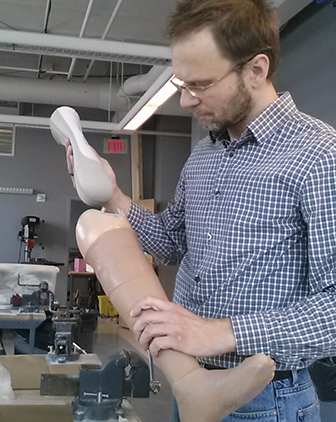
Subscribe to Pittwire Today
Get the most interesting and important stories from the University of Pittsburgh.Research Takes Strides Toward Making Prosthetic Limbs More Comfortable
This story is adapted from the spring/summer 2018 issue of FACETS magazine.
More than 2 million Americans live with some sort of limb loss, and while prosthetic devices help to restore function and improve quality of life, they can also create a new set of problems such as pressure sores and infection at the amputation site. These secondary complications reduce the likelihood that the amputee will wear the prosthetic device, further eroding the user’s ability to work or socialize.
Goeran Fiedler, assistant professor in the Master of Science in Prosthetics and Orthotics Program within the School of Health and Rehabilitation Sciences, envisions a way to make artificial limbs more comfortable to wear and less likely to cause secondary complications.
In an innovative, two-year study funded by the U.S. Department of Defense, Fiedler is researching the comparative effectiveness of a new type of liner that fits into the prosthetic socket of artificial limbs for individuals with below-knee amputations.
“The current standard of care requires the use of a flexible liner made of silicon or polyurethane gel that is worn directly between the skin and the rigid wall of the prosthetic socket,” explained Fiedler. “The liner sticks to the skin and keeps the prosthesis from slipping off when the leg is lifted.”
However, one of the primary side effects of the liner is excessive sweating of the residual limb. When the skin sweats, it loses contact with the liner. It then rubs against the material with every step. After a while, the rubbing causes pain and damage to the skin.
But a new generation of prosthetic liners are infused with phase-change material — a material that “melts” from a solid phase into a liquid phase at a temperature slightly above normal skin temperature. The melting has a cooling effect on the skin and prevents sweating.
Donnie Krimm, who has worn an artificial limb for more than 10 years, participated in Fiedler’s pilot study that compared the two types of liners.
“A liner is like a heavy rubber sock that you pull over your residual limb,” said Krimm. “You can imagine how hot that can feel, especially in the summer months. But I was completely comfortable wearing the temperature-controlled liner, even when the temperature hit 90 degrees last August.”
Fiedler’s study is investigating whether the differences between liners can lead to any other tangible benefits for the user. For example, he’s studying whether users will be able to wear the artificial limb for longer periods during the day, or for more days in a row — or if they will experience any complications.
Study participants are being recruited in the Pittsburgh and Philadelphia areas. “It is important to have multiple sites for a study like this, mostly for logistical reasons,” said Fiedler. “Recruiting 50 eligible participants from a small area is almost impossible, but having multiple sites increases the chances of having conditions that are most representative of reality.
“There may not be a big difference in demographics or anthropometrics between eastern and western Pennsylvania,” he said. “But there may well be differences in climate, as we have seen with this year’s winter storms on the East Coast. And climate is obviously a factor in our study on socket comfort.”
The double-blind, randomized study follows participants for 12 months, during which time they wear one type of liner for six months, then switch to the other. This allows them to wear both the conventional and phase-change material liners during hot and cold seasons.
The study tracks the number of days the prosthesis is used, the number of steps taken and other measures of activity. Participants also complete a standardized questionnaire to evaluate their experience.
Krimm reported that he was able to wear the phase-change material liner all day, every day, during the pilot study. “It felt very natural, and I had no problems with sweat,” he said.
According to Fiedler, the field of prosthetics does not often benefit from evidence-based research studies. The reason, he said, is simple: “All patients are different and one prosthesis does not look like the next. It’s virtually impossible to conduct randomized trials on prosthetic devices — but it is feasible to study liners, and that’s why we are excited about this study.”



